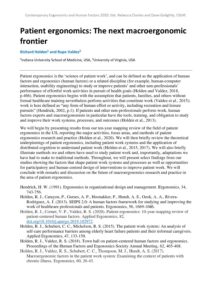| Document | Author Richard Holden and Rupa Valdez |
| Abstract Patient ergonomics is the ‘science of patient work’, and can be defined as the application of human factors and ergonomics (human factors) or a related discipline (for example, human-computer interaction, usability engineering) to study or improve patients’ and other non-professionals’ performance of effortful work activities in pursuit of health goals (Holden and Valdez, 2018, p.466). Patient ergonomics begins with the assumption that patients, families, and others without formal healthcare training nevertheless perform activities that constitute work (Valdez et al., 2015); work is here defined as “any form of human effort or activity, including recreation and leisure pursuits” (Hendrick, 2002, p.1). If patients and other non-professionals perform work, human factors experts and macroergonomists in particular have the tools, training, and obligation to study and improve their work systems, processes, and outcomes (Holden et al., 2013). |

